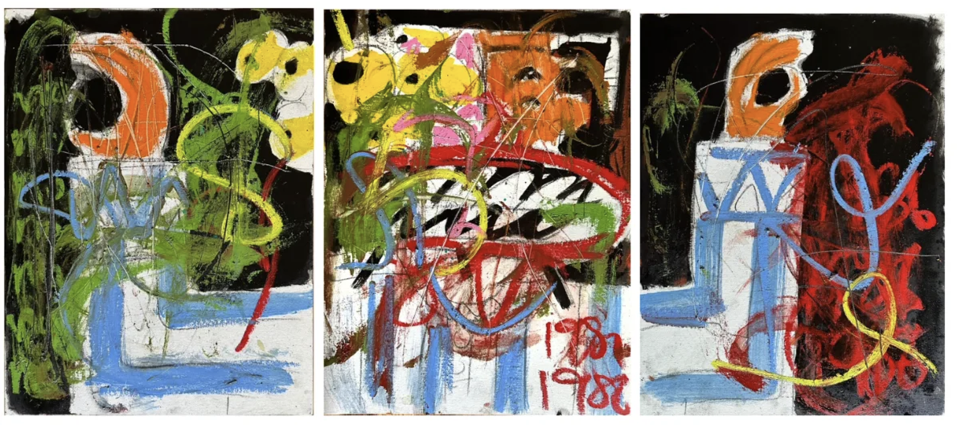Yellow squiggles flow from yellow sclera, as if taking note of what the eyes have witnessed. Small yellow dots trickle down the figure’s cheek, evoking tears. His mouth folly agape, and flooded with blue, suggest a portal, perhaps collecting more information and insight into what he’s seeing. The artist’s first name “Móyòsóré” is thrice scrawled under erasure, as if the figure has taken over the canvas and displaced or absorbed its creator. The scrawled text intermingles with the yellow lines emanating from the eyes, further extending the emotional narrative. The deep red background hints at urgency or terror, juxtaposed with the pale blue face that transcends the race of the figure who is crowned by a fila (cap) that symbolizes dignity, heritage, and identity in Yoruba culture, and may be worn differently in various stages of a man’s life to convey social status, marital status, ambition, and tradition.
The oil, oil stick, pigments, and graphite on canvas marries myriad cultural and self-referential images, symbols, and motifs, mostly notably Móyòsóré Martins’ signature Watchman figure. The array of ferocious brushstrokes, scratches, and painterly drips amplify the complex dialogue, inviting the viewer’s interpretation.
Opening today and on view until October 31 at Pulpo Gallery in Murnau, a German city on the edge of the Bavarian Alps, The Watchman is the first solo exhibition to focus exclusively on the Nigerian-born, New York-based artist’s inimitable creation of the same name. The artist better known to his international collectors as Móyò, has been evolving the character – a personal archetype, a spiritual sentinel, and a bridge between worlds – for over eight years, exploring his Yoruba ancestry and urban mythology.
The Watchman has been a constant companion to Martins on his life and creative journeys from Lagos, Nigeria, where he was raised by a Brazilian father and a Nigerian mother from Ekiti state, to his studio in Mott Haven, the Bronx, where he’s assembled an eclectic collection of art objects, ephemera, jazz records, and other curious finds that offer a window into his broad cultural influences and fancies. Both his African heritage and his new exploration of the verisimilitudes and vagaries of New York City life paint the ongoing development of The Watchman, sometimes featured as the key figure as in the monumental portrait, AH! (Face), 2024, as described above, or portrayed in multiples on a single canvas or as a triptych, or integrated into complex visual narratives that delve deeply into abstraction, Neo-Expressionism, and figuration.
Renowned financier Asher Edelman – who began collecting art in the 1960s and by the mid-1980s had amassed an enviable contemporary art collection including key works by Cy Twombly, Roy Lichtenstein, Andy Warhol, Jean-Michel Basquiat, Jasper Johns, Brice Marden, John Chamberlain, Keith Haring, Roy Lichtenstein, and others before they rocketed to blue chip auction stardom – has described Martins as “a better painter than Basquiat.” Edelman and his wife, Michelle Edelman – a trailblazer in art and design who has led Traffic Creative Management and TrafficArts since 1996 – acquired Martins’ first study titled Watchman (2018), recognizing a powerful force in the global art world.
“For him, The Watchman isn’t just a figure that appears in his work; it’s a personal guide, a spiritual presence, a way of seeing and holding space. This show invites us into that world, and it’s an honor to help bring it to life,” Michelle Edelman articulates.
Observing Martins at work in his studio reveals the depth and layering of both his artistic techniques – incorporating oil impasto and raw mixed media surfaces – and his visual storytelling, as multiple canvases transform into masterworks that demand careful attention to detail and a comprehensive contemplation of his incomparable oeuvre. What lies beneath the surface is hardly a starting point for grasping the breadth and enduring impact of each work.
Often a similar guise, The Watchman is fluid and fungible, and emerges in various forms such as Aura (2025), an oil, acrylic, aerosol, and graphite on canvas, which introduces a mighty seated figure who commands the viewer’s gaze.
“The idea behind Aura is the act of knowing and not accepting nothing less than what has been revealed. This is significantly curated to eventually be as opposed to one’s current state of mind,” Martins explains.
As the Pulpo Gallery examines the ongoing evolution and future incarnations of The Watchman through the lenses of Black futurism, cultural convergence, and essential inquiries into belonging and transformation, Crossing Art of New York, is showcasing Martins in a group show, Blue Planet Umbilicus, a collaboration with LDM Art Global, curated by Lydia Duanmu and Charles A. Riley II, PhD, on view through September 30. In July 2023, the Chelsea gallery presented a pop-up solo exhibition, Móyòsóré Martins: The Artist Journey.
Join Martins’ wife, Joanna L. Martins – a business owner and founder of CULTURESPUN, an anti-agency public relations company, as well as mother to the couple’s two young boys – at Crossing Art on Sept 17 from 5-6:30 p.m. for an art talk, “What’s the meaning of HOME for the time now?” She will be joined by Ray Zeng, founder of Aureva Innovation Corp. (which is hosting the talk along with LDM Art Global), and special guest Linda H Zhang, Ph.D, a collector and founder of Stonecreek Ventures and co-founder of Women in ETFs (exchange traded funds). The discussion will focus on displacement as well as the possibilities of belonging in a world that is constantly redefining itself.

